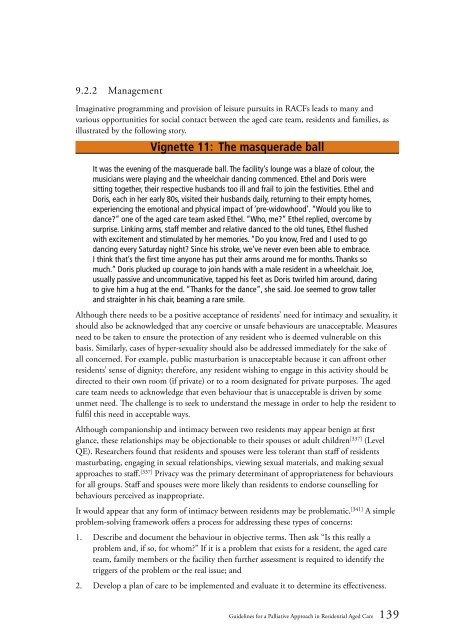Guidelines for a Palliative Approach in Residential Aged Care
Guidelines for a Palliative Approach in Residential Aged Care
Guidelines for a Palliative Approach in Residential Aged Care
You also want an ePaper? Increase the reach of your titles
YUMPU automatically turns print PDFs into web optimized ePapers that Google loves.
9.2.2 Management<br />
Imag<strong>in</strong>ative programm<strong>in</strong>g and provision of leisure pursuits <strong>in</strong> RACFs leads to many and<br />
various opportunities <strong>for</strong> social contact between the aged care team, residents and families, as<br />
illustrated by the follow<strong>in</strong>g story.<br />
Vignette 11: The masquerade ball<br />
It was the even<strong>in</strong>g of the masquerade ball. The facility’s lounge was a blaze of colour, the<br />
musicians were play<strong>in</strong>g and the wheelchair danc<strong>in</strong>g commenced. Ethel and Doris were<br />
sitt<strong>in</strong>g together, their respective husbands too ill and frail to jo<strong>in</strong> the festivities. Ethel and<br />
Doris, each <strong>in</strong> her early 80s, visited their husbands daily, return<strong>in</strong>g to their empty homes,<br />
experienc<strong>in</strong>g the emotional and physical impact of ‘pre-widowhood’. “Would you like to<br />
dance?” one of the aged care team asked Ethel. “Who, me?” Ethel replied, overcome by<br />
surprise. L<strong>in</strong>k<strong>in</strong>g arms, staff member and relative danced to the old tunes, Ethel flushed<br />
with excitement and stimulated by her memories. “Do you know, Fred and I used to go<br />
danc<strong>in</strong>g every Saturday night? S<strong>in</strong>ce his stroke, we’ve never even been able to embrace.<br />
I th<strong>in</strong>k that’s the first time anyone has put their arms around me <strong>for</strong> months. Thanks so<br />
much.” Doris plucked up courage to jo<strong>in</strong> hands with a male resident <strong>in</strong> a wheelchair. Joe,<br />
usually passive and uncommunicative, tapped his feet as Doris twirled him around, dar<strong>in</strong>g<br />
to give him a hug at the end. “Thanks <strong>for</strong> the dance”, she said. Joe seemed to grow taller<br />
and straighter <strong>in</strong> his chair, beam<strong>in</strong>g a rare smile.<br />
Although there needs to be a positive acceptance of residents’ need <strong>for</strong> <strong>in</strong>timacy and sexuality, it<br />
should also be acknowledged that any coercive or unsafe behaviours are unacceptable. Measures<br />
need to be taken to ensure the protection of any resident who is deemed vulnerable on this<br />
basis. Similarly, cases of hyper-sexuality should also be addressed immediately <strong>for</strong> the sake of<br />
all concerned. For example, public masturbation is unacceptable because it can affront other<br />
residents’ sense of dignity; there<strong>for</strong>e, any resident wish<strong>in</strong>g to engage <strong>in</strong> this activity should be<br />
directed to their own room (if private) or to a room designated <strong>for</strong> private purposes. The aged<br />
care team needs to acknowledge that even behaviour that is unacceptable is driven by some<br />
unmet need. The challenge is to seek to understand the message <strong>in</strong> order to help the resident to<br />
fulfil this need <strong>in</strong> acceptable ways.<br />
Although companionship and <strong>in</strong>timacy between two residents may appear benign at first<br />
glance, these relationships may be objectionable to their spouses or adult children [337] (Level<br />
QE). Researchers found that residents and spouses were less tolerant than staff of residents<br />
masturbat<strong>in</strong>g, engag<strong>in</strong>g <strong>in</strong> sexual relationships, view<strong>in</strong>g sexual materials, and mak<strong>in</strong>g sexual<br />
approaches to staff. [337] Privacy was the primary determ<strong>in</strong>ant of appropriateness <strong>for</strong> behaviours<br />
<strong>for</strong> all groups. Staff and spouses were more likely than residents to endorse counsell<strong>in</strong>g <strong>for</strong><br />
behaviours perceived as <strong>in</strong>appropriate.<br />
It would appear that any <strong>for</strong>m of <strong>in</strong>timacy between residents may be problematic. [341] A simple<br />
problem-solv<strong>in</strong>g framework offers a process <strong>for</strong> address<strong>in</strong>g these types of concerns:<br />
1. Describe and document the behaviour <strong>in</strong> objective terms. Then ask “Is this really a<br />
problem and, if so, <strong>for</strong> whom?” If it is a problem that exists <strong>for</strong> a resident, the aged care<br />
team, family members or the facility then further assessment is required to identify the<br />
triggers of the problem or the real issue; and<br />
2. Develop a plan of care to be implemented and evaluate it to determ<strong>in</strong>e its effectiveness.<br />
<strong>Guidel<strong>in</strong>es</strong> <strong>for</strong> a <strong>Palliative</strong> <strong>Approach</strong> <strong>in</strong> <strong>Residential</strong> <strong>Aged</strong> <strong>Care</strong> 139
















